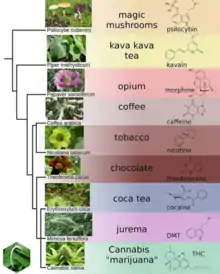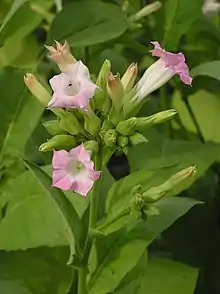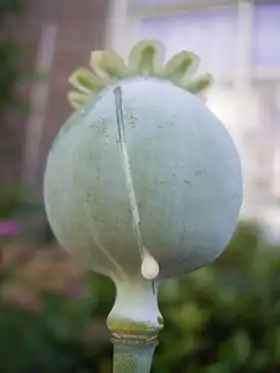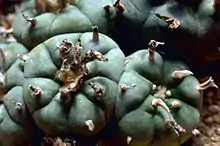Psychoactive plant
Psychoactive plants are plants, or preparations thereof, that upon ingestion induce psychotropic effects. As stated in a reference work:
Psychoactive plants are plants that people ingest in the form of simple or complex preparations in order to affect the mind or alter the state of consciousness.[1]

Psychoactivity may include sedative, stimulant, euphoric, deliriant, and hallucinogenic effects.
Several hundred psychoactive plants are known.[1] Some popular examples of psychoactive plants include Coffea arabica (coffee), Camellia sinensis (tea), Nicotiana tabacum (tobacco), and Cannabis (including hashish).
Psychoactive plants have been used ritually (e.g., peyote as an entheogen), medicinally (e.g., opium as an analgesic), and therapeutically (e.g., cannabis as a drug) for thousands of years.[2] Hence, the sociocultural and economic significance of psychoactive plants is enormous.
Examples of psychoactive plants
In the table below, a few examples of significant psychoactive plants and their effects are shown. For further examples, see List of psychoactive plants.
| Plant | Common preparation | Main active constituent | Psychoactive effects | ||
|---|---|---|---|---|---|
| Coffea arabica |  | coffee | caffeine |  | stimulant, temporarily warding off drowsiness and restoring alertness |
| Nicotiana tabacum |  | tobacco | nicotine |  | stimulant, relaxant |
| Cannabis sativa | .JPG.webp) | hashish | tetrahydrocannabinol |  | euphoria, relaxation, and increase in appetite |
| Erythroxylum coca |  | coca | cocaine | stimulant, appetite suppressant | |
| Papaver somniferum |  | opium | morphine |  | analgesia, sedation, euphoria |
| Lophophora williamsii |  | peyote | mescaline |  | hallucinogen |
Botanical taxonomy
Botanical taxonomy delimits groups of plants and describes and names taxa based on these groups to identify other members of the same taxa. The circumscription of taxa is directed by the principles of classification, and the name assigned is governed by a code of nomenclature. In the plant kingdom (Plantae), almost all psychoactive plants are found within the flowering plants (angiosperms).[3] There are many examples of psychoactive fungi, but fungi are not part of the plant kingdom. Some important plant families containing psychoactive species are listed below. The listed species are examples only, and a family may contain more psychoactive species than listed.
- Solanaceae (nightshades)
- Nicotiana tabacum
- Datura stramonium
- Rubiaceae
- Coffea arabica
- Theaceae
- Camellia sinensis
- Cannabaceae
- Cannabis sativa
- Cannabis indica
- Cactaceae
- Lophophora williamsii
- Echinopsis pachanoi
- Papaveraceae
- Erythroxylaceae
- Erythroxylum coca
- Celastraceae
- Convolvulaceae
- Ipomoea tricolor
- Lamiaceae
- Salvia divinorum
Phytochemistry
Phytochemistry is the study of phytochemicals, which are chemicals derived from plants. Phytochemists strive to describe the structures of the large number of secondary metabolites found in plants, the functions of these compounds in human and plant biology, and the biosynthesis of these compounds. Plants synthesize phytochemicals for many reasons, including to protect themselves against insect attacks and plant diseases. The compounds found in plants are of many kinds, but most can be grouped into four major biosynthetic classes: alkaloids, phenylpropanoids, polyketides, and terpenoids. Active constituents of the majority of psychoactive plants fall within the alkaloids (e.g., nicotine, morphine, cocaine, mescaline, caffeine, ephedrine), a class of nitrogen-containing natural products. Examples of psychoactive compounds of plant origin that do not contain nitrogen are tetrahydrocannabinol (a phytocannabinoid from Cannabis sativa) and salvinorin A (a diterpenoid from Salvia divinorum).
See also
- List of psychoactive plants
- Phytochemistry
- Psychoactive cacti
- Psychoactive fungi
- Psychoactive drugs
- Ethnobotany
- Ethnopharmacology
- Christian Rätsch
- Richard Evans Schultes
References
- Rätsch, Christian (2004). The Encyclopedia of Psychoactive Plants: Ethnopharmacology and Its Applications. Park Street Press, U.S. ISBN 978-0892819782.
- Schultes, Richard Evans (1976). Hallucinogenic Plants. Illustrated by Elmer W. Smith. New York: Golden Press. pp. 2, 9, 34. ISBN 0-307-24362-1.
- Schultes, Richard Evans (2001). Plants of the Gods: Their Sacred, Healing, and Hallucinogenic Powers. Rochester, Vermont: Healing Arts Press. ISBN 978-089281979-9.